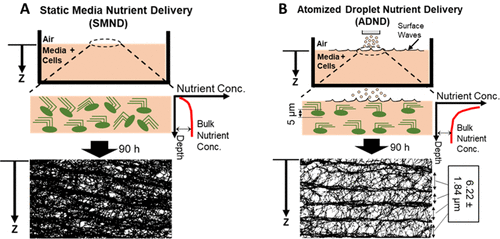当前位置:
X-MOL 学术
›
Biomacromolecules
›
论文详情
Our official English website, www.x-mol.net, welcomes your feedback! (Note: you will need to create a separate account there.)
Effect of Atomized Delivery of Nutrients on the Growth Characteristics and Microstructure Morphology of Bacterial Cellulose.
Biomacromolecules ( IF 6.2 ) Pub Date : 2019-12-06 , DOI: 10.1021/acs.biomac.9b01249 Anna-Christina Amason 1 , James F Nowak , Johnson Samuel , Richard A Gross 1
Biomacromolecules ( IF 6.2 ) Pub Date : 2019-12-06 , DOI: 10.1021/acs.biomac.9b01249 Anna-Christina Amason 1 , James F Nowak , Johnson Samuel , Richard A Gross 1
Affiliation

|
This work demonstrates a general strategy for introducing remarkable changes in matrix organization and, consequently, functional properties of bacterial cellulose (BC). BC-producing cells were induced, using a well-defined atomized droplet nutrient delivery (ADND) system, to form pellicles with a regular layered morphology that persists throughout the mat depth. In contrast, the morphology of mats formed by conventional static medium nutrient delivery (SMND) is irregular with no distinguishable pattern. ADND also resulted in larger meso-scale average pore sizes but did not alter the fibril diameter (∼70 nm) and crystallinity index (92-95%). The specific modulus and specific tensile strength of ADND mats are higher than those of SMND mats. This is due to the regularity of dense layers that are present in ADND mats that are able to sustain tensile loads, when applied parallel to these layers. The density of BC films prepared by ADND is 1.63-fold lower than that of the SMND BC film. Consequently, the water contents (g/g) of ADND- and SMND-prepared BC mats are 263 ± 8.85 and 99.6 ± 2.04, respectively. A model that rationalizes differences in mat morphology resulting from these nutrient delivery methods based on nutrient and oxygen concentration gradients is proposed. This work raises questions as to the extent that ADND can be used to fine-tune the matrix morphology and how the resulting lower density mats will alter the diffusion of actives from the films to wound sites and increase the ability of cells to infiltrate the matrix during tissue engineering.
中文翻译:

营养物的雾化输送对细菌纤维素的生长特性和微观结构形态的影响。
这项工作演示了引入显着变化的基质组织以及因此细菌纤维素(BC)的功能特性的一般策略。使用定义明确的雾化液滴营养物输送(ADND)系统诱导产生BC的细胞,以形成具有规则层状形态的防护膜,该防护膜可在整个垫层深度上持续存在。相反,通过常规的静态培养基营养物输送(SMND)形成的垫子的形态是不规则的,没有可分辨的图案。ADND还导致较大的中尺度平均孔径,但未改变原纤维直径(〜70 nm)和结晶度指数(92-95%)。ADND垫的比模量和比拉伸强度高于SMND垫。这是由于在平行于这些层施加时,ADND垫中存在的致密层的规则性,它们能够承受拉伸载荷。通过ADND制备的BC膜的密度比SMND BC膜的密度低1.63倍。因此,ADND和SMND制备的BC垫的含水量(g / g)分别为263±8.85和99.6±2.04。提出了一个基于营养物和氧气浓度梯度合理化这些营养物输送方法导致的垫层形态差异的模型。这项工作提出了以下问题:ADND可用于微调基质形态的程度,以及由此产生的较低密度的垫子如何改变活性物质从薄膜到伤口部位的扩散,并增加细胞在过程中渗透基质的能力。组织工程。当平行于这些层应用时。通过ADND制备的BC膜的密度比SMND BC膜的密度低1.63倍。因此,ADND和SMND制备的BC垫的含水量(g / g)分别为263±8.85和99.6±2.04。提出了一种基于营养物和氧气浓度梯度合理化这些营养物输送方法导致的垫层形态差异的模型。这项工作提出了以下问题:ADND可用于微调基质形态的程度,以及由此产生的较低密度的垫子如何改变活性物质从薄膜到伤口部位的扩散,并增加细胞在过程中渗透基质的能力。组织工程。当平行于这些层应用时。通过ADND制备的BC膜的密度比SMND BC膜的密度低1.63倍。因此,ADND和SMND制备的BC垫的含水量(g / g)分别为263±8.85和99.6±2.04。提出了一种基于营养物和氧气浓度梯度合理化这些营养物输送方法导致的垫层形态差异的模型。这项工作提出了以下问题:ADND可用于微调基质形态的程度,以及由此产生的较低密度的垫子如何改变活性物质从薄膜到伤口部位的扩散,并增加细胞在过程中渗透基质的能力。组织工程。ADND和SMND制备的BC垫的含水量(g / g)分别为263±8.85和99.6±2.04。提出了一种基于营养物和氧气浓度梯度合理化这些营养物输送方法导致的垫层形态差异的模型。这项工作提出了以下问题:ADND可用于微调基质形态的程度,以及由此产生的较低密度的垫子如何改变活性物质从薄膜到伤口部位的扩散,并增加细胞在过程中渗透基质的能力。组织工程。ADND和SMND制备的BC垫的含水量(g / g)分别为263±8.85和99.6±2.04。提出了一种基于营养物和氧气浓度梯度合理化这些营养物输送方法导致的垫层形态差异的模型。这项工作提出了以下问题:ADND可用于微调基质形态的程度,以及由此产生的较低密度的垫子如何改变活性物质从薄膜到伤口部位的扩散,并增加细胞在过程中渗透基质的能力。组织工程。
更新日期:2019-12-07
中文翻译:

营养物的雾化输送对细菌纤维素的生长特性和微观结构形态的影响。
这项工作演示了引入显着变化的基质组织以及因此细菌纤维素(BC)的功能特性的一般策略。使用定义明确的雾化液滴营养物输送(ADND)系统诱导产生BC的细胞,以形成具有规则层状形态的防护膜,该防护膜可在整个垫层深度上持续存在。相反,通过常规的静态培养基营养物输送(SMND)形成的垫子的形态是不规则的,没有可分辨的图案。ADND还导致较大的中尺度平均孔径,但未改变原纤维直径(〜70 nm)和结晶度指数(92-95%)。ADND垫的比模量和比拉伸强度高于SMND垫。这是由于在平行于这些层施加时,ADND垫中存在的致密层的规则性,它们能够承受拉伸载荷。通过ADND制备的BC膜的密度比SMND BC膜的密度低1.63倍。因此,ADND和SMND制备的BC垫的含水量(g / g)分别为263±8.85和99.6±2.04。提出了一个基于营养物和氧气浓度梯度合理化这些营养物输送方法导致的垫层形态差异的模型。这项工作提出了以下问题:ADND可用于微调基质形态的程度,以及由此产生的较低密度的垫子如何改变活性物质从薄膜到伤口部位的扩散,并增加细胞在过程中渗透基质的能力。组织工程。当平行于这些层应用时。通过ADND制备的BC膜的密度比SMND BC膜的密度低1.63倍。因此,ADND和SMND制备的BC垫的含水量(g / g)分别为263±8.85和99.6±2.04。提出了一种基于营养物和氧气浓度梯度合理化这些营养物输送方法导致的垫层形态差异的模型。这项工作提出了以下问题:ADND可用于微调基质形态的程度,以及由此产生的较低密度的垫子如何改变活性物质从薄膜到伤口部位的扩散,并增加细胞在过程中渗透基质的能力。组织工程。当平行于这些层应用时。通过ADND制备的BC膜的密度比SMND BC膜的密度低1.63倍。因此,ADND和SMND制备的BC垫的含水量(g / g)分别为263±8.85和99.6±2.04。提出了一种基于营养物和氧气浓度梯度合理化这些营养物输送方法导致的垫层形态差异的模型。这项工作提出了以下问题:ADND可用于微调基质形态的程度,以及由此产生的较低密度的垫子如何改变活性物质从薄膜到伤口部位的扩散,并增加细胞在过程中渗透基质的能力。组织工程。ADND和SMND制备的BC垫的含水量(g / g)分别为263±8.85和99.6±2.04。提出了一种基于营养物和氧气浓度梯度合理化这些营养物输送方法导致的垫层形态差异的模型。这项工作提出了以下问题:ADND可用于微调基质形态的程度,以及由此产生的较低密度的垫子如何改变活性物质从薄膜到伤口部位的扩散,并增加细胞在过程中渗透基质的能力。组织工程。ADND和SMND制备的BC垫的含水量(g / g)分别为263±8.85和99.6±2.04。提出了一种基于营养物和氧气浓度梯度合理化这些营养物输送方法导致的垫层形态差异的模型。这项工作提出了以下问题:ADND可用于微调基质形态的程度,以及由此产生的较低密度的垫子如何改变活性物质从薄膜到伤口部位的扩散,并增加细胞在过程中渗透基质的能力。组织工程。



























 京公网安备 11010802027423号
京公网安备 11010802027423号